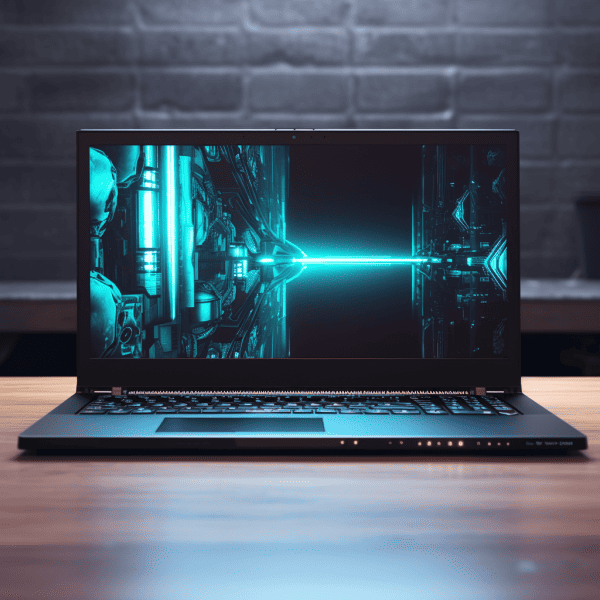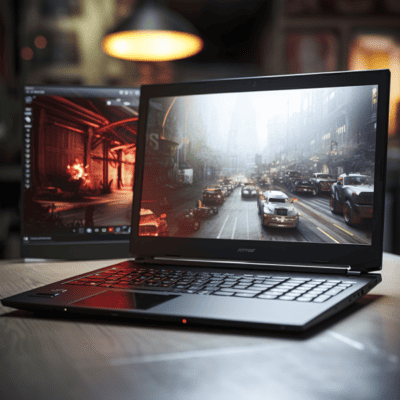Gaming Laptops, Blog
Why Are Gaming Laptops Cheaper Than Desktops? Cost Analysis
As an avid gamer, I used to assume a powerful desktop was my only option for serious, high-quality gameplay.
But lately I’ve noticed you can get impressive gaming laptops for hundreds less than equivalent decked-out desktops. What gives? Aren’t desktops supposed to be the ultimate gaming machines?
Why are gaming laptops cheaper than desktops?
After researching the components and capabilities of the latest gaming laptops versus desktops, it became clear to me there are valid reasons for the cost difference. While desktops used to dominate on performance, innovations in mobile computing have vastly closed that gap in recent years.
Let’s take a factual look at why price-conscious gamers can feel confident choosing an affordable gaming laptop these days without sacrificing quality. Understanding the trade-offs and savvy shopping tips can help you decide which option is the best fit. You may be surprised at how far premium laptops have come to deliver desktop-level power in a portable package.
Whether you’re new to PC gaming or a veteran building your dream rig, I’ll walk through the key factors that allow gaming laptops to offer more bang for your buck. You deserve an immersive, smooth gaming experience without breaking the bank. Let’s unlock the secrets to more gaming power per dollar.
KEY TAKEAWAY
Why are gaming laptops cheaper than desktops?
Gaming laptops are generally cheaper than desktops (1) due to factors such as manufacturing costs, component choices, and economies of scale. Understanding these reasons can help gamers make informed decisions when choosing between the two options.
Cost Factors and Manufacturing Efficiency
Mass Production Benefits

Source: Random Tech Videos
One key reason gaming laptops have become so cost-effective is the manufacturing efficiencies from mass production. The major laptop brands produce millions of units to meet huge consumer demand. They can optimize the assembly process in a way custom desktop builders can’t match.
Precision, automated fabrication of laptop components allow them to be churned out faster and cheaper. Streamlined installation in large factories slashes build costs. This high-volume production generates big savings that brands can pass on through competitive pricing.
Desktops built one-by-one lack these advantages. Pre-fab laptop parts benefit from economies of scale.
Economies of Scale in Laptop Manufacturing
Building on the mass production concept, “economies of scale” means the average cost per unit drops as volume increases. Producing millions of gaming laptops annually allows brands to negotiate cheaper component costs from suppliers and spread design expenses over more units.
The high fixed costs of developing advanced laptops can be divided over each device sold, making the individual pricing fall. High demand and strong laptop sales enable these economies of scale. Custom-built desktops can’t match this cost efficiency.
Streamlined Component Integration in Laptops
Another production advantage for gaming laptop brands is having full control over component integration from the start. They design casings and parts specifically to fit together in their assembly process.
With desktops, there are far more variables in components working together, requiring custom configuration. Gaming laptop makers optimize integration between chips, wiring, cooling, and frames early on to remove assembly inefficiencies. The result is reduced production costs.
Laptop Components and Performance Optimization
Integration of GPU and CPU
Gaming laptops locating the graphics processing unit (GPU) and central processing unit (CPU) on the same motherboard allows for efficient data transfer and communication. With desktops, the discrete GPU is its own separate card, creating latency.
Carefully integrating the GPU and CPU in gaming laptops eliminates delays and bottlenecks, boosting performance. This proprietary integration enhancement is only possible manufacturing laptops at scale.
Power-Efficient Components
Gaming laptop makers invest heavily in power-efficient yet high-performing components tailored for their compact form. Advanced GPUs, CPUs, RAM, and SSDs designed for optimal wattage allows more juice for gaming capabilities.
With desktops, choosing components is much less constrained by thermal and battery limits. Gaming laptop engineers neighbor components for maximum efficiency given size and cooling restraints. This proprietary coordination enhances performance per watt.
Performance per Watt Efficiency
That leads into “performance per watt” – a key metric where gaming laptops excel due to component optimization. The specialized parts squeeze every ounce of speed out of each watt of power available within thermal ceilings.
That optimization is only possible when engineering laptops holistically from the ground up versus dropping varied desktop parts into a case. Carefully balancing performance and efficiency yields advantages.
Limited Upgradeability and Standardization
Challenges of Laptop Component Upgrades
Unlike desktops, gaming laptops are not built for easy component swapping and upgrades. Their tightly integrated construction makes DIY upgrades extremely difficult, often impossible. This limited upgradeability provides cost benefits.
Laptop brands can streamline models around standardized parts since customers won’t modify them later. Developing a few configurations using the same optimized components keeps costs consistent.
With desktops, interchangeable parts complicate pricing and inventory. Overall, limited laptop upgrades simplify manufacturing.
Proprietary Designs Impacting Upgradability
Adding to the upgrade challenges, gaming laptops feature lots of proprietary components like motherboards that only work in specific models. Custom-designed parts are made solely by and for the brand.
This lack of aftermarket cross-compatibility lets brands optimize performance but discourages users from swapping parts later. Fewer upgrades means longer ownership and less pricing volatility – a win for accessibly priced gaming laptops.
Impact on Overall Cost due to Limited Upgrades
In summary, gaming laptops avoid the complexities of enabling extensive user-driven upgrades after purchase. The limited flexibility helps streamline development and inventory management, keeping costs contained.
Desktops lean into the open ecosystem of varied parts working together, which hinders economies of scale. The focused integration of gaming laptops contains expense passed onto consumers.
Portable Design and Compact Form Factor

Lightweight Materials and Design Innovations
Gaming laptops achieve powerful performance in a portable form factor through clever design innovations. Lightweight metals, thinner cooling systems, and compact component layouts pack a punch while minimizing weight.
Product engineers meticulously shave off grams and millimeters wherever possible. Unique high-strength magnesium alloys withstand battlefield conditions while keeping laptops around 4-5lbs. Ingenious designs balance sturdiness and mobility.
Engineering for Portability without Sacrificing Performance
Of course, prioritizing a slim gaming laptop profile presents thermal challenges. Effective cooling in a tight space required advances in fan technology, venting arrays, heat pipes, and chassis materials to dissipate heat.
Brands poured R&D into fitting top-tier gaming prowess into thin bodies. While desktops offer flexibility for huge graphics cards and elaborate liquid cooling setups, laptops represent an engineering triumph.
Trade-offs Between Portability and Performance
There are still some trade-offs – desktops ultimately allow bigger, badder graphics cards and CPUs with their spacious frames and robust cooling capacity. But for many gamers, the portability of a moderately thinner, lighter laptop is worth a modest performance compromise.
Gaming laptop engineers continue innovating to minimize that compromise. Given their technical wizardry thus far, the performance gap may close entirely soon.
More details about which is better for gaming can be found here.
Market Competition and Consumer Demand
Intense Competition in the Gaming Laptop Market
The thriving gaming laptop market is fiercely competitive (2), with brands constantly innovating to beat each other on price versus performance. This forces prices down and value up in their fight for market share.
Cost-conscious gamers win with affordable but capable laptops benefitting from the competitive landscape. Desktop pricing is far less impacted by market competitions.
Manufacturers Targeting Budget-Conscious Gamers
Knowing cost is the primary barrier for many gamers, laptop brands are smartly positioning models with robust gaming capability at entry-level prices. They create designated budget gaming lines to capture this underserved segment.
Again, the larger industry dynamics allow gaming laptop manufacturers to serve up heavy-hitting performance at relatively low cost compared to singular custom desktop builders lacking scale.
Balancing Price and Features to Capture Market Share
In the end, major gaming laptop makers wield extensive resources and expertise in straddling the line between affordability and quality. Their business model depends on delivering the strongest specs possible per dollar spent to entice gamers.
This laser focus results in incredible bang-for-buck gaming laptops that desktops have difficulty rivaling on price. And market forces will only continue driving innovation and value upward. Exciting times ahead!
Conclusion
In closing, while desktop PCs used to be the undisputed kings for gaming, don’t overlook modern gaming laptops if your budget is limited. Their combination of power, features, and mobility delivers excellent value for the money.
Focus on the specs and components that matter most for the types of games you play. Shop smart and look for gaming laptop deals. With the right settings adjustments, you can achieve desktop-caliber performance andgraphics in an affordable, compact machine.
I hope shining a light on why gaming laptop pricing has become so competitive removes any concerns about sacrificing experience. Really dig into reviews and benchmarks for the laptop you’re considering rather than assuming inferiority. There are so many great options today.
Which one will you choose, PC or laptop? Game on without breaking the bank. Thanks for learning with me – happy to continue the conversation online if you have any other gaming tech questions! My DMs are open.
References
- https://www.gamesradar.com/gaming-laptop-vs-desktop-which-setup-should-you-choose/
- https://www.enterpriseappstoday.com/news/gaming-laptop-market-size-is-valued-at-usd-9-07-billion-in-2023-growing-at-a-cagr-of-6-5.html
Related Articles
- https://workrift.com/gaming-laptop-vs-desktop-which-is-better-for-gaming/
- https://workrift.com/gaming-laptops-vs-pc/



